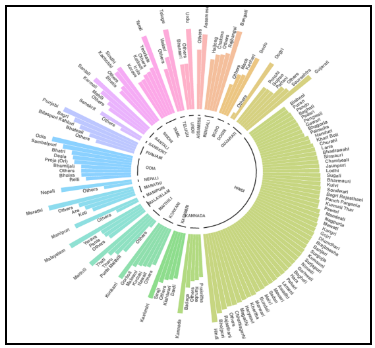Monday, 6th November 2023
Indian Railways’ Revenue Problems
In News
While Indian Railways has boosted its capital expenditure after integrating the rail budget with the main budget, its operating ratio, indicating expenses relative to revenue, hasn't shown improvement.
Current issues facing the Indian Railways
- Indian Railways is facing a significant debt issue as it increasingly relies on Gross Budgetary Support (GBS) and Extra Budgetary Resources (EBS) due to a lack of surplus funds.
- Despite the growing debt, the Railway is investing significantly in the belief that it will stimulate economic growth, including manufacturing, services, tax revenue, and job opportunities.
- However, it must avoid financial instability seen in entities like Air India.
- Furthermore, Indian Railways is grappling with a decline in its market share for transporting essential goods, such as coal and Exim containers.
- This includes a decrease from 70% to 60% in the rail share for coal transportation from 2011 to 2020 and a fluctuating share for Exim containers, reaching 13% in 2021-22.
- Lastly, there has been a notable drop in Net Tonne Kilometres (NTKM), with declines of 4% and 5% in 2015-16 and 2016-17.
- Over the seven-year period ending in 2021-22, NTKM showed a growth rate of 3.5%, considerably lower than that of road transport.
What are the enduring challenges within the Indian railway system?
- The Indian Railways (IR) grapples with significant financial performance issues, notably the stark contrast between its profitable freight segment and the loss-making passenger segment.
- Between April and July 2023, the annual growth in freight volume and revenue is only 1% and 3%, respectively, despite India's economy growing at a rate of 7%.
- The IR's artificial division of cargo into goods and parcels, driven by tariff rules, handling procedures, and monitoring practices, hinders efficiency and does not align with the needs of shippers.
- It's essential for the IR to abandon this artificial division and categorize cargo based on its characteristics as either bulk or non-bulk, which could be referred to as value-added.
- The Indian Railways also faces tough competition from road transport, which is growing faster than rail transport.
- This competition, combined with fluctuating Net Tonne Kilometres (NTKM), poses challenges for the IR to maintain and expand its share in freight transportation, necessitating an overhaul in railway transportation practices.
- Despite 15 years of privatization, containerized domestic cargo accounts for only 1% of IR's loading and 0.3% of the country's total freight.
- High haulage rates and the risk of market development with potential losses contribute to this underperformance.

How can the transportation of cargo by Indian Railways be made more efficient and effective?
- The Indian Railways should phase out the use of parcel trains and special heavy parcel vans (VPH) trains due to high tariffs that often exceed truck rates. Instead, covered wagons offer a more efficient alternative.
- Indian Railways should provide shippers with more flexible options that suit various cargo sizes, similar to passengers booking train berths based on their needs.
- To boost the railways' share in bulk cargo, the high cost of railway sidings discouraging smaller industries should be addressed. Common-user facilities at cargo aggregation and dispersal points, especially in mining clusters, industrial areas, and large cities, are essential.
- Tariff structures can be adjusted based on the quantity loaded to incentivize volumetric loading. Cargo aggregators should be encouraged for better efficiency.
- Investment in infrastructure modernization, including high-speed rail, station redevelopment, track doubling, coach refurbishing, GPS tracking, and digitalization, is urgently needed for safety, efficiency, and cost reduction.
|
UPSC Previous Year Questions Prelims (2015) Q. With reference to bio-toilets used by the Indian Railways, consider the following statements:
Which of the statements given above is/are correct? (a) 1 only Ans: (d) |
Source: TH
Annual Survey of India’s City-Systems 2023
In News
The ASICS 2023 report from the Janaagraha Centre for Citizenship and Democracy identifies the difficulties and limitations encountered by local governments in Indian cities.
Key findings of the report
- Eastern states, followed by southern states, have relatively stronger urban legislations.
- Urban legislations are not easily accessible to the public, with only 49% of states/UTs making municipal legislations available online.
- Nearly 39% of India's capital cities lack active master plans for urban development.
- Local governments in Indian cities have restricted control over finances, including taxation and borrowing, requiring state government approval in most cases.
- There are variations in financial control across different city categories, with mayors in megacities lacking direct election and limited financial authority.
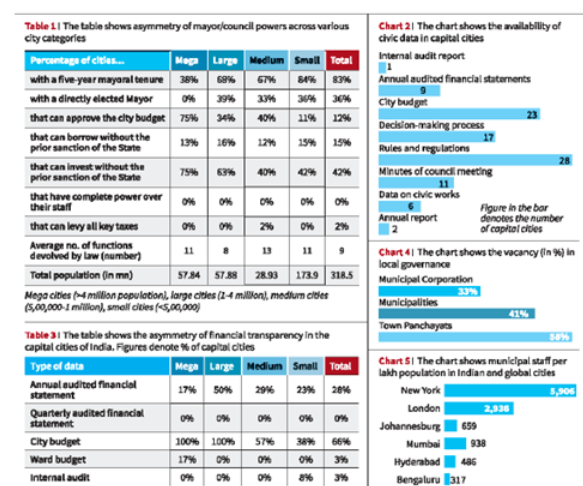
- Mayors and city councils have limited influence over staff appointments, affecting accountability and efficient administration.
- Many Indian cities struggle with financial transparency, including the lack of quarterly audited statements and limited dissemination of annual audited financial statements.
- A significant number of positions in India's municipal corporations, municipalities, and town panchayats remain vacant.
- Indian cities have fewer staff per population and less administrative autonomy compared to global metropolises like New York, London, and Johannesburg.
About local government
- Local self-government involves the management of local affairs by elected local bodies, encompassing both rural and urban areas as the third tier of government.
- In rural regions, the Panchayati Raj Institution (PRI) was constitutionally established through the 73rd Constitutional Amendment Act of 1992 to promote grassroots democracy and rural development.
- Urban areas have various types of urban local governments, including Municipal Corporations, Municipalities, Notified Area Committees, and others, as defined by the 74th Amendment Act in 1992.
- This amendment introduced Part IX-A and Articles 243-P to 243-ZG, along with the 12th Schedule detailing 18 functional areas for municipalities under Article 243W.
Key Recommendations for Local Governance Improvement:
- Enable local governments to collect a wider range of taxes for independent revenue generation.
- Reduce the need for state government approval for borrowing, especially for well-managed municipalities.
- Devolve administrative powers to local governments, allowing them to make key staff appointments and promotions, including municipal commissioners and senior management teams.
- Enforce Public Disclosure Laws consistently across states and union territories to ensure regular publication of civic information.
- Establish online platforms for easy citizen access to information, including internal audit reports, annual reports, minutes of meetings, and decision-making processes.
- Create a mechanism for benchmarking Indian cities against global metropolises to identify best practices in urban governance, staffing levels, and financial management
- Encourage the adoption of successful strategies from global peers.
- Promote citizen engagement through public consultations, feedback mechanisms, and participatory budgeting.
- Establish platforms for citizens to express concerns and suggestions, ensuring a more responsive government.
- Implement digital governance tools and platforms to streamline administrative processes, enhance transparency, and provide online services to citizens.
- Initiate e-governance projects to reduce bureaucratic hurdles and improve efficiency in local governance.
|
UPSC Previous Year Questions Prelims (2017) Q. Local self-government can be best explained as an exercise in (a) Federalism Ans: (b) |
Source: TH
Melting of West Antarctica's Ice Sheet
In News
A recent study presents concerning forecasts regarding the unavoidable melting of the West Antarctic ice sheet as a consequence of the warming of ocean waters.
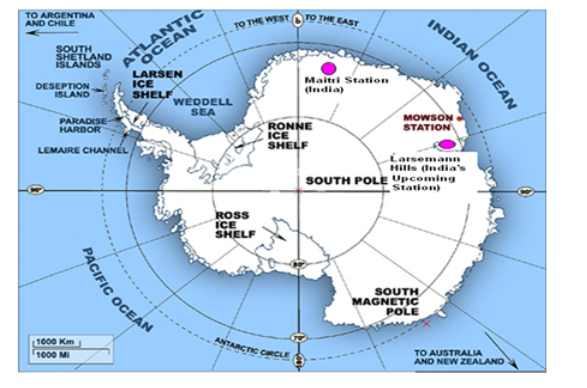
What is the significance of ice sheets? And in what way do ice sheets impact sea levels?
- Ice sheets are massive expanses of glacial ice that cover over 50,000 square kilometres of land, like the West Antarctic ice sheet, containing significant freshwater.
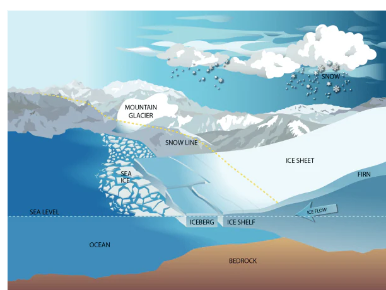
- Greenland and Antarctica, the world's two major ice sheets, hold around two-thirds of Earth's freshwater.
- Changes in ice sheet mass contribute to global mean sea level rise or fall.
- The West Antarctic Ice Sheet's melting is driven by various mechanisms, including warm ocean waters eroding ice shelves, leading to sea level rise.
- Recent findings indicate accelerated ice shelf melting, causing concerns for coastal regions worldwide.
- India, with its dense population and extensive coastline, faces vulnerability to sea level rise, necessitating urgent adaptive strategies.
The path ahead
- Environmental protection in Antarctica is achieved through strict adherence to the Antarctic Treaty and associated agreements, regulating human activities, waste management, and minimizing environmental impact.
- Innovation is crucial for developing efficient and environmentally friendly materials and infrastructure.
- Researchers are also exploring geoengineering techniques like solar radiation management to potentially mitigate ice melting, but these methods require further investigation for effectiveness and environmental consequences before practical application.
|
UPSC Previous Year Questions Prelims (2021) With reference to the water on the planet Earth, consider the following statements:
Which of the statements given above is/are correct? (a) 1 only Ans: (b) |
Source: IE
State Food Safety Index 2022- 2023
In News
The recently published State Food Safety Index (SFSI) for 2022-2023, by the Food Safety and Standards Authority of India (FSSAI), provides insights into how well Indian states are ensuring food safety.
Key highlights of the report

- Most of the 20 large Indian states, including Maharashtra, Bihar, Gujarat, and Andhra Pradesh, have seen a decline in their SFSI scores over the past five years.
- After adjusting for a new parameter introduced in 2022-2023, 15 out of 20 states recorded lower SFSI scores compared to 2019.
- This parameter, measuring the availability of testing infrastructure, saw a significant drop, with Gujarat and Kerala as the best performers and Andhra Pradesh as the worst.
- The 'Compliance' parameter, measuring licensing and inspections, also saw a decline, with Punjab and Himachal Pradesh leading and Jharkhand receiving the lowest score.
- The 'Consumer Empowerment' parameter, focusing on consumer initiatives, saw Tamil Nadu as the top performer.
- The 'Human Resources and Institutional Data' parameter, measuring the availability of human resources, had lower scores in 2022-2023, even for top performers like Tamil Nadu and Uttar Pradesh.
- Improvement in 'Training and Capacity Building' parameter improved in 2022-2023 compared to 2019.
- In the new 'Improvement in SFSI Rank' parameter, only Punjab showed significant improvement, while 14 out of 20 states received 0 points.
Source: IE
Impact of Export Restriction of Rice
In News
In July 2023, India imposed a ban on the export of non-basmati white rice due to diminishing public stock in the Central pool, rising cereal prices, and concerns about the unpredictable Monsoon, which had both global and domestic price implications.
What were the reasons for India implementing limitations on rice exports?
- India imposed restrictions on rice exports to ensure domestic food security by
- Maintaining sufficient stock
- Stabilizing rising domestic prices
- As a precaution against the uncertainties related to unpredictable or uneven monsoons, which significantly impact agricultural production.
Implications of this ban
- Restrictions on India's rice exports have had notable repercussions on
- Supply
- Availability
- Pricing in both domestic and worldwide markets
- Resulting in a substantial global rice price surge following the export ban, continued elevated domestic rice prices, and broader economic consequences, including price fluctuations, disruptions in international trade, and implications for food security in importing countries.
How Does India Conduct Rice Exports?
- India stands as the world's largest rice exporter, accounting for approximately 40% of global rice exports, equivalent to 56 million tonnes in 2022, according to the United States Department of Agriculture (USDA).
- These exports encompass two primary categories: Basmati and Non-basmati rice.
- Basmati Rice: During the 2022-23 period, India exported 45.61 lakh metric tonnes of Basmati rice, with top destinations including Iran, Saudi Arabia, Iraq, the UAE, and Yemen.
- Non-Basmati Rice: In the same fiscal year, India exported 177.91 lakh metric tonnes of non-Basmati rice, which includes varieties like Sona Masuri and Jeera rice.
- Key Destinations for Non-Basmati White Rice: Key export destinations for non-Basmati white rice include Benin, Madagascar, Kenya, Cote D'Ivoire, Mozambique, and Vietnam.
|
UPSC Previous Year Questions Prelims (2019) Q. Among the following, which one is the largest exporter of rice in the world in the last five years? (a) China Ans: (b) Prelims (2020) Q 2. According to India’s National Policy on Biofuels, which of the following can be used as raw materials for the production of biofuels?
Select the correct answer using the code given below: (a) 1, 2, 5 and 6 only Ans: (a) Exp: The National Policy on Biofuels, 2018, allows production of ethanol from damaged food grains like wheat, broken rice, etc., which are unfit for human consumption. The Policy also allows conversion of surplus quantities of food grains to ethanol, based on the approval of the National Biofuel Coordination Committee. The Policy expands the scope of raw material for ethanol production by allowing use of sugarcane juice, sugar containing materials like sugar beet, sweet sorghum, starch containing materials like corn, cassava, damaged food grains like wheat, broken rice, rotten potatoes, unfit for human consumption for ethanol production. Hence, 1, 2, 5 and 6 are correct. Therefore, option (a) is the correct answer |
Source: IE
Bahrain - Edukemy Current Affairs
In News
Due to the escalating attacks on Gaza, Bahrain has decided to withdraw its ambassador from Israel.
About Bahrain

- Officially the Kingdom of Bahrain, is an island country in West Asia.
- It is situated on the Persian Gulf, and comprises a small archipelago made up of 50 natural islands and an additional 33 artificial islands, cantered on Bahrain Island which makes up around 83 per cent of the country's landmass.
- Bahrain is situated between Qatar and the northeastern coast of Saudi Arabia, to which it is connected by the King Fahd Causeway.
- Bahrain spans some 760 square kilometres (290 sq. mi), and is the third-smallest nation in Asia after the Maldives and Singapore.
- The capital and largest city is Manama.
Source: Aljazeera
White Hydrogen - Edukemy Current Affairs
In News
In northeastern France, two scientists have uncovered a significant reservoir of "white hydrogen," representing one of the most substantial concentrations of this environmentally friendly energy source ever detected.
About White Hydrogen
- White hydrogen is a naturally occurring, clean-burning energy source found in the Earth's crust, distinct from green hydrogen produced through renewable energy electrolysis and Gray, brown, or black hydrogen obtained from fossil fuels.
- Its significance lies in being an abundant and underutilized clean energy source with an estimated cost of approximately $1 per kilogram, making it a more cost-effective option compared to green hydrogen at $6 per kilogram.
- White hydrogen deposits have been discovered globally, including in the US, eastern Europe, Russia, Australia, Oman, France, and Mali.
Source: OP
Systematic Voters' Education and Electoral Participation
In News
J&K Govt constitute UT Level Core Committee for implementation of SVEEP
About SVEEP
- Initiated in 2009 as the flagship program of the Election Commission of India (ECI) for voter education, its primary objective is to foster an inclusive and participative democracy by motivating all eligible citizens to vote, make informed decisions, and choose candidates ethically.
- Other associated initiatives include
- Introduction of the "None of the Above" (NOTA)
- Implementation of Voter Verified Paper Audit Trail (VVPAT) machines to ensure voting accuracy.
- Observance of National Voters' Day on January 25th since 2011 to commemorate the ECI's formation.
- Efforts to decriminalize elections by requiring candidates to disclose their criminal records.
- Development of the Cvigil app, which allows citizens to provide time-stamped, evidence-based proof of Model Code of Conduct and Expenditure Violations, including live photos and videos with automatic location data.
Source: CTN
Global Hunger Hotspots - Edukemy Current Affairs
In News
A report from WFP and FAO underscores the critical need for urgent attention in 22 countries or territories, as a lack of funding hinders essential support.
Key highlights of the report
- The Hunger Hotspots report, jointly released by WFP and FAO, highlights 18 critical humanitarian emergencies in 22 countries or territories, drawing attention to the potential risk of food insecurity and starvation in these regions, including Palestine, Burkina Faso, Mali, South Sudan, and Sudan
- This necessitates urgent humanitarian action amid rising conflict and other contributing factors such as climate-related disasters and economic issues.
- The report emphasizes the need for prompt responses, preparedness, and anticipatory actions to address these impending crises, citing challenges associated with funding shortfalls and various destabilizing factors, from conflict and climate change to economic struggles.
India has implemented various initiatives to ensure food security
- National Food Security Mission to enhance crop production
- PM Garib Kalyan Ann Yojana providing free grains to those covered by the National Food Security Act
- One Nation One Ration Card system to address hunger issues
- Pradhan Mantri Kisan Samman Nidhi to support small and marginal farmers
- National Food Security Act, legally entitling a significant portion of the population to receive subsidized food grains under the Targeted Public Distribution System, with the eldest woman of the household as the ration card head.
Source: WFP
Kawah Ijen Crater Lake - Edukemy Current Affairs
In News
The Copernicus Sentinel-2 mission, known for its optical Earth surface imagery, has recently captured breathtaking pictures of Kawah Ijen Crater Lake.
About Kawah Ijen
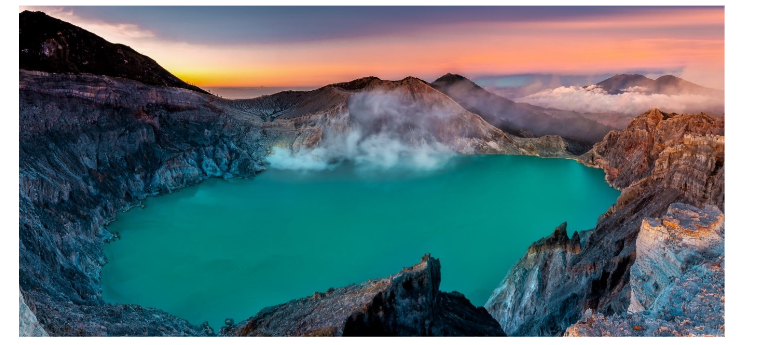
- Kawah Ijen, situated in East Java, Indonesia, is a volcanic crater lake within the Ijen volcano complex, known for its dazzling turquoise-coloured lake, which derives its vivid hue from a high concentration of dissolved sulfuric acid and other minerals.
- This highly acidic lake holds the distinction of being the largest of its kind in the world and is designated as a UNESCO World Biosphere Reserve.
- The Ijen volcano complex remains active, and Kawah Ijen is a site where volcanic activity is observed, releasing sulphur gases that can ignite to create mesmerizing blue flames, often referred to as "blue fire."
- The region surrounding Kawah Ijen is renowned for traditional sulphur mining.
About The Copernicus Sentinel-2 mission
- This European mission, known as a wide-swath, high-resolution, multi-spectral imaging mission, involves two polar-orbiting satellites orbiting in the same sun-synchronous orbit but with a 180° phase difference.
- Its primary objective is to observe and track changes in land surface conditions.
- With its expansive 290 km swath width and frequent revisits (10 days at the equator using one satellite and 5 days with two satellites under clear skies, equivalent to 2-3 days at mid-latitudes), this mission facilitates the monitoring of surface changes on Earth.
Source: HT
Vision India@2047: Strategic Planning Benefits
This editorial delves into the government's strategy for India's development by 2047, set to be revealed by the Prime Minister in early 2024.
About Vision India@2047 Plan and its significance
- Vision India@2047 is an initiative launched by India's top policy think tank, NITI Aayog, with the aim of charting a comprehensive development plan for the nation over the next 25 years.
- The project's primary objectives encompass transforming India into a global leader in innovation, advancing human development and social welfare, and becoming a prominent advocate for environmental sustainability.
- Significance:
- Attaining a USD 30 trillion economy with a per-capita income ranging from USD 18,000 to USD 20,000, coupled with robust public finances and a thriving financial sector.
- Revolutionizing infrastructure in both rural and urban areas, striving for world-class standards.
- Nurturing and strengthening key industries through mergers and restructuring to create 3-4 global industry leaders.
- Achieving self-reliance in the defence and space sectors, while enhancing India's global influence.
- Collaborating with foreign R&D organizations to establish top-tier laboratories within India and elevate at least 10 Indian institutions into the global top 100 rankings.
The Present Condition and Future Outlook of the Indian Economy
- India presently ranks as the fifth-largest economy in nominal terms and the third-largest in terms of Purchasing Power Parity (PPP).
- As of 2022, India's GDP had already surpassed that of the UK and France.
- Multiple forecasts indicate that India's GDP is on track to surpass Japan and Germany by 2030.
- Rating agency S&P predicts India's nominal GDP will surge from USD 3.4 trillion in 2022 to USD 7.3 trillion by 2030. Such rapid economic growth would position India as the second-largest economy in the Asia-Pacific region.
- Preliminary forecasts from NITI Aayog indicate that India's exports will be valued at USD 8.67 trillion in 2047, with imports valued at USD 12.12 trillion.
- Moreover, India's average life expectancy is projected to increase from 67.2 in 2021 to 71.8, and the literacy rate is expected to rise from 77.8% in 2021 to 89.8%.
Obstacles on the Path to India's $30 Trillion Economy Vision
- Risk of getting stuck in the middle-income trap
- Concerns arise that during its journey toward becoming a developed economy, India might become ensnared in the Middle-Income Trap, slowing down after reaching a per capita income of $5,000 to $6,000.
- An aging population
- India's present population stands at approximately 1.4 billion and is expected to reach its peak at 1.64 billion in 2048, subsequently declining to 1.45 billion by the year 2100.
- Need for higher and sustained economic growth
- While the Indian economy is experiencing robust growth at 8%, this growth rate might not be sufficient to reach the desired goal; India needs to achieve an even higher and sustainable growth rate.
- Complex geopolitics
- India confronts a multifaceted and ever-evolving geopolitical landscape, characterized by increasing tensions with China, Pakistan, and neighbouring countries, as well as shifting relationships with major powers such as the US and Russia.
- Underdeveloped agriculture and manufacturing sectors
- Enhancing agricultural productivity and competitiveness, despite employing over half the workforce but contributing only 17% to the GDP, and reinvigorating the stagnant manufacturing sector with a consistent 15% GDP share, all while creating employment opportunities for the growing population.
- Declining labour force participation
- India's labour force participation rate (LFPR) was 40.4% in 2022-2023, considerably below the global average of 61.4%. Furthermore, India has experienced a declining LFPR over the years, particularly among women.
Way forward
To achieve its vision of becoming a USD 30 trillion economy, India should prioritize greater divestitures of inefficient public sector enterprises, reduce taxes for the middle class, improve labour force participation through education and skill development initiatives, accelerate infrastructure development, harness its manufacturing potential, boost private investment through incentives and reforms, and increase capital accumulation with substantial support for infrastructure projects and manufacturing.
|
UPSC Previous Year Questions Mains (2020) Q. Define potential GDP and explain its determinants. What are the factors that have been inhibiting India from realizing its potential GDP? |
Source: TH
Share the article
Edukemy’s Current Affairs Quiz is published with multiple choice questions for UPSC exams
MCQ
Get Latest Updates on Offers, Event dates, and free Mentorship sessions.

Get in touch with our Expert Academic Counsellors 👋
FAQs
UPSC Daily Current Affairs focuses on learning current events on a daily basis. An aspirant needs to study regular and updated information about current events, news, and relevant topics that are important for UPSC aspirants. It covers national and international affairs, government policies, socio-economic issues, science and technology advancements, and more.
UPSC Daily Current Affairs provides aspirants with a concise and comprehensive overview of the latest happenings and developments across various fields. It helps aspirants stay updated with current affairs and provides them with valuable insights and analysis, which are essential for answering questions in the UPSC examinations. It enhances their knowledge, analytical skills, and ability to connect current affairs with the UPSC syllabus.
UPSC Daily Current Affairs covers a wide range of topics, including politics, economics, science and technology, environment, social issues, governance, international relations, and more. It offers news summaries, in-depth analyses, editorials, opinion pieces, and relevant study materials. It also provides practice questions and quizzes to help aspirants test their understanding of current affairs.
Edukemy's UPSC Daily Current Affairs can be accessed through:
- UPSC Daily Current Affairs can be accessed through Current Affairs tab at the top of the Main Page of Edukemy.
- Edukemy Mobile app: The Daily Current Affairs can also be access through Edukemy Mobile App.
- Social media: Follow Edukemy’s official social media accounts or pages that provide UPSC Daily Current Affairs updates, including Facebook, Twitter, or Telegram channels.


